Reviewed by: Cindy Hatcher
Did you know this rare Alabama forest is found nowhere else on earth?
Reading time: 7 minutes
Sponsored

In 1999, one of the largest army bases in the nation, Fort McClellan, was shuttered.
Undeterred, the local community in and around Anniston and Calhoun County quickly began redeveloping the historic military installation, bringing in new businesses and industries.
But, it wasn’t only businesses they saved. The community also saved a forest.
Through an act of Congress in 2004, they turned an old bombing range at Fort McClellan into a wildlife refuge. How did they make this 180 degree shift in mission?
For decades before its closing, the Army trained soldiers how to shoot off bombs by lobbing them into the mountains surrounding Fort McClellan.
The artillery would occasionally catch the woods on fire, preserving the fire-dependent, old-growth mountain longleaf pine forests. Basically, the fire from the bombs helped the pine trees grow.
Thanks to the bombing range, one of the largest remnants of mountain longleaf pine, a rare forest-type found primarily on our mountains here in Alabama, was preserved.
Because of the foresight of the community and the U.S. Congress, 21 years later, the Mountain Longleaf National Wildlife Refuge is now one of the most biodiverse and intact mountain longleaf forests left in Alabama.

Now that I’ve grabbed your attention with bombs and fire, let’s learn how this uniquely Alabama forest was created, why it matters today and what is being done to protect it.
About mountain longleaf pine forests

A quick natural history lesson about mountain longleaf pine forests…
- Mountain longleaf (or montane longleaf) is a subset of the larger native longleaf pine ecosystem that extends across the southern U.S. along the coastal plains from Virginia all the way to Texas.
- Because of our robust climate — extreme heat, big storms and frequent lightning strikes — the longleaf forest in the South evolved with fire.
- The frequent fires created the perfect environment for longleaf forests to dominate over 90 million acres of the South’s landscape before European settlement.
- Longleaf pine trees provided the fuel in their pine needles that allowed fire to sweep across the southeast, creating a pine forest that was open and more park-like, unlike the thick tree farms we see today.
How did the longleaf forest in Alabama move from the coastal plain into the mountains?
Unlike traditional longleaf, the mountain longleaf pine system did not stay put in the valleys and coastal plains.
Alabama’s first mountains of the Appalachians feature southern-facing slopes that get really hot in the summer. Add lightning during one of our tropical storms, and subsequent fires would rage for hundreds of thousands of acres over time, with only a natural structure like a river system stopping it.
The fire essentially found its way into the pine forests extending up into the mountains.
This only happened in Alabama and a little bit in northwest Georgia—not in the mountains of North Carolina or South Carolina since mountain longleaf pine can’t survive above 2000 feet elevation.
Mountain longleaf trees helped establish Alabama towns
Mountain longleaf, which looks a lot like the Truffula trees in Dr. Seuss’ book “The Lorax,” helped build and fuel some of Alabama’s earliest settlements around the Birmingham area and east Alabama.
“These trees not only grow, but they grow old. This area (Mountain Longleaf National Wildlife Refuge) has trees as old as 300 years. One of the most important things about mountain longleaf is its relationship to the iron ore that’s also found in the ground.
What happened was, years ago, the trees became fuel that were burned to create charcoal to actually drive the furnaces that would allow settlers to take the iron ore and melt it into a usable iron product.
Without the trees creating the charcoal, and without the trees creating some of the best railroad ties to move the stuff around, Anniston, Oxford and a lot of these communities never would have been established.”
Pete Conroy, Director of Jacksonville State University Little River Canyon Center
Beyond the 9,200-acre Mountain Longleaf National Wildlife Refuge, the largest mountain longleaf forests remain in the following places:
- Fenvkvcēkv (pronounced finuh-guh-jee-guh) Creek Preserve at Flagg Mountain in Coosa County, the terminus of the Pinhoti Trail
- Wheeler Mountain in Bibb County
- Birmingham’s Oak Mountain State Park
- Mountain Longleaf National Wildlife Refuge at Fort McClellan in Anniston
- Talladega Mountains in Eastern Alabama moving north toward the corner of the state seeping into a bit of Northwest Georgia
Saving mountain longleaf pine is challenging

Without fire, mountain longleaf pine forests will continue to disappear from our landscape.
“Here’s what happens. A pine cone falls out of the tree and lands on the leaves. Unless there’s something called seed to soil contact, that little seed won’t grow a root into the dirt. If the fire burns away the leaves, then you get that seed to soil contact.”
Pete Conroy, Jacksonville State University
Because our cities and suburbs continue to expand, it makes it harder to conduct controlled burns.
For example, Moss Rock Nature Preserve in Hoover has mountain longleaf pine on its property, but it is highly unlikely controlled burn will be used because of the growing number of nearby homes.
Protecting and regenerating mountain longleaf for the future

How do we save this rare Alabama forest? The answer is collaboration, according to The Nature Conservancy (TNC) in Alabama
“We need to help our partners at both the state, federal and the local level manage the mountain longleaf system by actively using prescribed fire or setting the woods on fire, frankly, to ensure that the system has the regular fire rotation every couple of years it needs to remain healthy.”
Mitch Reid, Director, The Nature Conservancy in Alabama
Working closely with numerous groups and agencies, TNC and their partners burn between 50,000 and 80,000 acres a year of mountain longleaf forest habitat.

Some of the agencies they work with include:
- Student Conservation Association
- U.S. Forest Service
- Alabama Forestry Commission
- U.S. Fish and Wildlife Service
- Alabama State Parks
In addition to working on public lands, TNC’s partners educate and support private landowners in their efforts to restore and grow mountain longleaf.
Why saving mountain longleaf matters

Why do mountain longleaf and longleaf pine forests matter in Alabama? It is our state tree.
“We didn’t advocate for the designation of Longleaf as our state tree for nothing. This pine represents so much. It tells the story of Alabama’s history, natural heritage, economy, and our conservation values, which is why the state legislature officially made it the state tree in 1997. Now it’s up to all of us to protect it where it exists.”
Pete Conroy, Director of Jacksonville State University Little River Canyon Center
Whether it’s a former bombing range or Oak Mountain State Park, TNC’s Reid added why efforts to save mountain longleaf matters:
“We’ve got to do all we can because it doesn’t really exist anywhere else. It’s going to be up to us here in Alabama to save it.”
Learn more about TNC’s efforts to bring back fire and mountain longleaf HERE.
Next up – Paint Rock Valley
Throughout 2025, we have been examining animals and landscapes only found in Alabama. In our next story we look at Alabama’s remarkable Paint Rock Valley.
Sponsored by:




